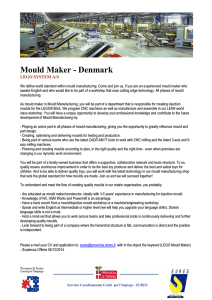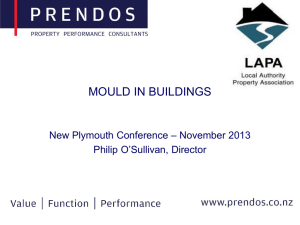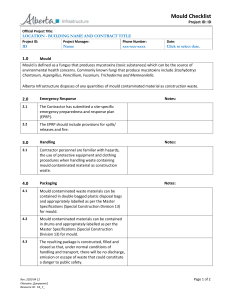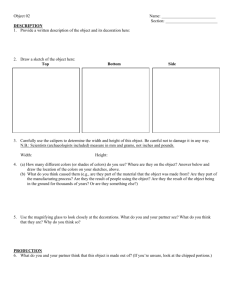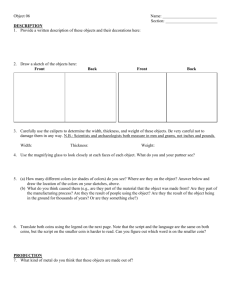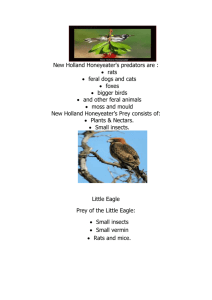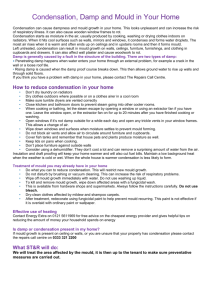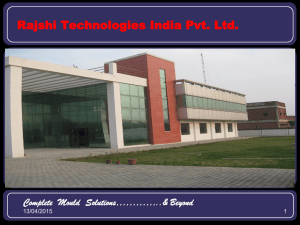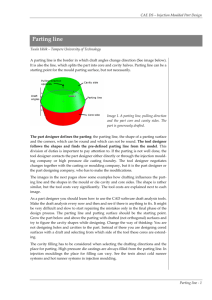Checklist for variothermal control Project Date Company Name Posit
advertisement
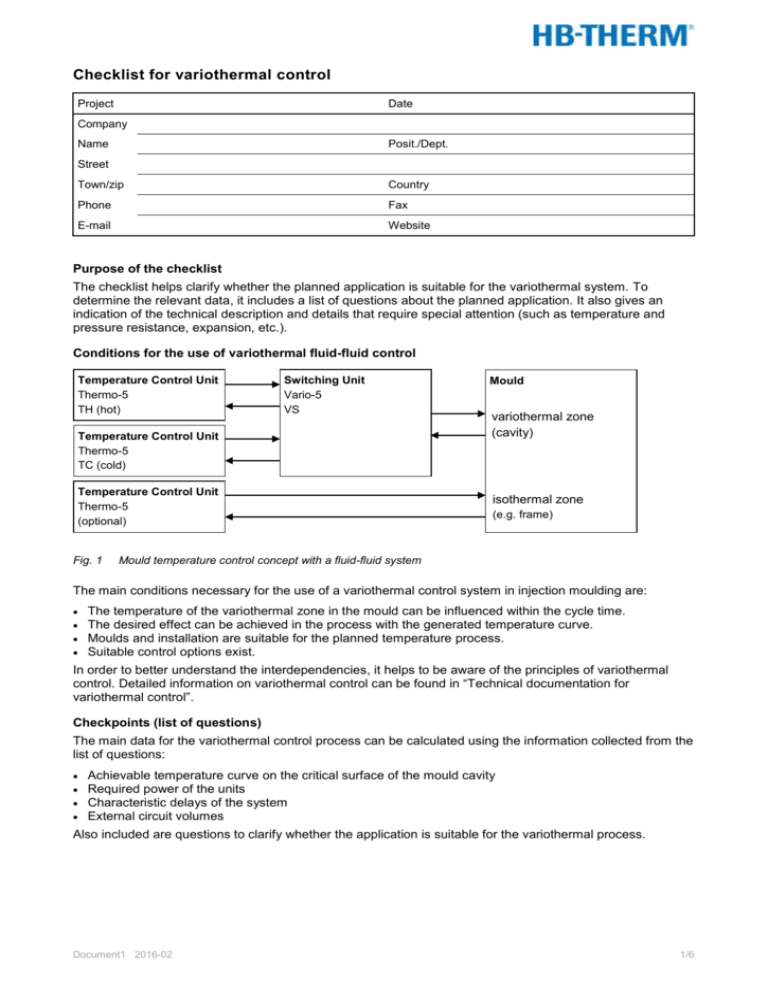
Checklist for variothermal control Project Date Company Name Posit./Dept. Street Town/zip Country Phone Fax E-mail Website Purpose of the checklist The checklist helps clarify whether the planned application is suitable for the variothermal system. To determine the relevant data, it includes a list of questions about the planned application. It also gives an indication of the technical description and details that require special attention (such as temperature and pressure resistance, expansion, etc.). Conditions for the use of variothermal fluid-fluid control Temperature Control Unit Thermo-5 TH (hot) Switching Unit Vario-5 VS Temperature Control Unit Thermo-5 TC (cold) Temperature Control Unit Thermo-5 (optional) Fig. 1 Mould variothermal zone (cavity) isothermal zone (e.g. frame) Mould temperature control concept with a fluid-fluid system The main conditions necessary for the use of a variothermal control system in injection moulding are: The temperature of the variothermal zone in the mould can be influenced within the cycle time. The desired effect can be achieved in the process with the generated temperature curve. Moulds and installation are suitable for the planned temperature process. Suitable control options exist. In order to better understand the interdependencies, it helps to be aware of the principles of variothermal control. Detailed information on variothermal control can be found in “Technical documentation for variothermal control”. Checkpoints (list of questions) The main data for the variothermal control process can be calculated using the information collected from the list of questions: Achievable temperature curve on the critical surface of the mould cavity Required power of the units Characteristic delays of the system External circuit volumes Also included are questions to clarify whether the application is suitable for the variothermal process. Document1 2016-02 1/6 1 Process No. Checkpoint 1.1 Reason for variothermal control Helps choose the optimum variothermal process and identifies possible limits. 1.2 Result with isothermal control Were parts with isothermal control already produced or sampled, and if so, how? 1.3 Answer Comments Weld line Thin wall (injection pressure) Reproduction accuracy Other (what?) No Yes Main line temp. Cycle time Quality °C s Material Processed plastic 1.4 Upper temperature Cavity surface temperature at the end of the heating phase, typically at the start of injection 1.5 °C Lower temperature Cavity surface temperature at the end of the cooling phase, typically at part ejection 1.6 °C Cycle time Planned cycle time 1.7 s Heating time Planned heating time (normally from ‘mould open’ to ‘start injection’) 1.8 Frame temperature control Temperature control in the non-variothermal mould zones? 1.9 s None Exists °C Cooling water temperature Maximum cooling water temperature °C Comments Document1 2016-02 2/6 2 Mould No. Checkpoint 2.1 Material Answer Comments Mould material (variothermal zone) 2.2 Weight Total weight of the mould 2.3 kg Number of cavities How many identical/similar cavities to have variothermal control? 2.4 Variothermal zone On which side of the mould is the variothermal zone located? 2.5 Layout of temperature control channels Fixed side (nozzle) Movable side (ejector) Both sides Sketch In cases of geometries that are difficult to describe, attach a drawing or 3D model. 1) Temperature control channel of the variothermal circuit (all cavities) 2.6 Diameter of temperature control channel Main diameter of the channel used for variothermal control 2.7 Drilled Milled (w x d) d: w: d: 1) Length of variothermal tempering circuit Complete length of the channel which is subjected to the variothermal temperature changes (without the feed channels according to Pos. 2.12) 2.8 mm 1) Distance from temperature control channel to mould cavity Centre of temperature control channel to surface of the mould cavity 2.9 mm 1) Distance between the temperature control channels Centre to centre 2.10 2.11 Yes No, sketch required Variothermal zone as insert No Yes, not insulated Yes, insulated (how?) 1) Yes No, inflow channels Diameter Total length 1) Feed channels inside mould mm mm 1) Connecting lines Only the dimensions of the connecting lines between the switching unit and mould, as well as the circuit bridges on the mould (variothermal control circuits, all cavities) 1) Attach temperature control diagram if necessary 1) Are the circuits used for variothermal control all connected in series? Is the variothermal zone connected directly by tube sections (no long inflow channels running through mould)? 2.13 mm Connection of the temperature control channels Is the variothermal zone designed as an insert? 2.12 mm 1) mm mm Internal diameter Length mm mm Drawings or CAD data are required for geometries or channel layouts that are difficult to describe. The work required for the assessment can increase considerably. In this case the work will be billed after prior consultation (optional service). Comments Document1 2016-02 3/6 3 Control No. Checkpoint 3.1 Machine signals Can heating and cooling both be controlled directly from the machine or is only a clock signal available? 3.2 Temperature sensor Is there a temperature sensor in the variothermal zone of the mould? 3.3 Answer Heating and cooling Only clock signal None (limit switch necessary) Non-existent Exists (describe position, sketch) Control Is switching purely time-controlled or temperature-controlled through mould sensors? Comments Time-controlled Temperature-controlled Temperature control is only possible through a machine, which must be equipped for this. Comments Document1 2016-02 4/6 4 General No. Checkpoint 4.1 Water quality Is the available water quality suitable for the intended variothermal control system (working temperatures)? 4.2 No Yes (clarification necessary) Yes No (modification necessary) Temperature gradients In the variothermal control process temperatures in the mould locally change heavily. Is it certain that the mould will not be damaged from this (slides getting stuck, adverse effects on cavity ventilation, etc.)? 4.5 Yes No (clarification necessary) Material durability Are all the materials which the variothermal circuit is comprised of suitably temperature- and pressure-resistant (typically 180 °C, 25 bar)? 4.4 Comments Additional heaters Are there any additional heating elements available to support variothermal control processes? 4.3 Answer Yes No (modification necessary) Special Are there any scenarios in the application which could be adversely affected by the variothermal operation? No Yes (clarification necessary) Note: The questions 4.3 to 4.5 are questions that concern safety which, if not properly clarified, can lead to damage to moulds or the installation! Comments Document1 2016-02 5/6 5 Results The results are based on the information given and complementary assumptions; they are normally determined and entered by HB-Therm. No. Checkpoint Answer 5.1 Suitability for variothermal control Yes No Is the intended application suitable for variothermal fluid-fluid control? 5.2 Hot unit (TH) Minimum values 5.3 Cold unit (TC) Minimum values 5.4 Temperature Heating capacity °C kW Temperature Cooling capacity °C kW K @ Pumping capacity (both units identical) Minimum values 5.5 Comments Flow rate @ pressure External circuit volume Temperature control channels with hoses from switching unit to mould and mould connections 5.6 L Characteristic delay time After switching, time until the temperature change arrives at the cavity surface 5.7 2) 2) Recommended unit type, cold (TC) HB- Recommended switching unit (VS) Minimum requirement 5.10 2) HB- Minimum requirement 5.9 s Recommended unit type, hot (TH) Minimum requirement 5.8 L/min bar HB- Recommended accessories (without hoses, fittings, cables) Proximity switch IR temperature sensor The type of unit (single or modular unit) and the required interfaces and remote control depend on the needs of the application. Comments Date / Name Document1 2016-02 / 6/6
